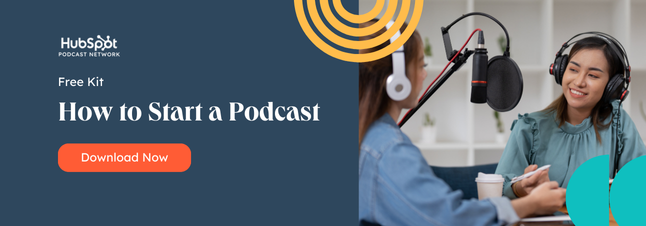With these tactics, you can identify podcasters with a price-point and audience target that makes sense for your brand. Then, you can work with them and leverage their expertise by sponsoring the content they've made. Alternatively, you could also create a native ad that aligns with their discussion topics.
We'll cover podcasting's biggest marketing opportunities, where podcasting is headed, and the demographics who tune in the most.
Table of Contents:
Podcasts and Advertising

- In 2022, 82% of marketers plan to continue investing the same amount or increase their investment in podcasts or other audio content. (HubSpot)
- Podcast ad spending is expected to hit $1.74 billion this year. (Statista)
- 39% of Information Technology companies plan to leverage podcast advertising in 2022. (HubSpot)
- The average podcast ad slot costs between $10 to $50, with additional premium fees for shows with high listenership. (HubSpot)
- 18% of U.S.-based companies plan to leverage podcasts and audio content in their marketing strategies. (HubSpot)
- 54% of podcast consumers say that they are more likely to consider the brands they hear advertised on podcasts. (Edison Research)
- 38% of marketers working for retail companies say podcast advertising is the media channel with the biggest ROI. (HubSpot)
- Podcast advertising revenue is expected to pass $2 billion in 2022. (IAB Podcast Ad Revenue Report)

Podcast Growth
- In 2021, there were over 2 million active podcasts. (Podcast Insights)
- By April 2021, there were over 48 million podcast episodes. (Podcast Insights)
- Monthly podcast listeners grew by 6.1% to 125 million listeners in 2022. (eMarketer)
- 73% of Americans age 12 and up have listened to podcasts in the past month. (Buzzsprout)
- Between 2021 and 2022, the number of people over the age of 12 in the U.S. who listened to podcasts increased from 57% to 62%. (Edison Research)
Podcast Demographics
- Roughly 79% of people over the age of 12 in the U.S. are familiar with podcasts. (Edison Research)
- 53% of podcast listeners are men. (Edison Research)
- 41% of millennials listen to podcasts weekly. (Jam Street Media)
- 53% of men and 46% of women listen to podcasts in 2022. (Edison Research)
- 66% of podcast listeners have a college degree and an average income of $75,000 per year. (Buzzsprout)
- The biggest increase in podcast listenership in the past year has come from those in the 12-to-34 age group. (Edison Research)
Podcast Listener Behaviors
- 38% of people listen to podcasts monthly while 26% of people listen to podcasts weekly. (Edison Research)
- While 49% of podcast listeners tune in from home, 22% listen in the car. (Podcast Insights)
- Roughly 30% of people learn about podcasts from online search while about 20% of listeners say they hear about them from other friends or word of mouth. (Buzzsprout)

- Podcast listeners are more likely to own a smart speaker. (Buzzsprout)
- Podcasts are the number one audio source by time of consumption among podcast listeners. (Edison Research)
- 50% of podcast Super Listeners agree that podcast ads are the best way to reach them. (Edison Research)
- Millennials and Gen Z are 5% more likely to listen to podcasts for professional reasons than older generations. (EX-IQ)
- Roughly 50% of customer service reps have listened to a podcast at work. (EX-IQ)
- While 39.2% of people who listen to podcasts at least monthly listen via Apple Podcasts, 26.4% use Spotify. (Buzzsprout)
- More than half of millennials listen to educational podcasts. (EX-IQ)
- 62% of podcast listeners say they'd be more likely to share podcasts with friends if they were able to share one short segment or highlight of it, rather than an entire episode. (EX-IQ)
- In 2021, dynamic ad insertion accounted for 84% of podcast advertising revenue. 40% of podcast ads were host-read. (IAB Podcast Ad Revenue Report)
- The amount of branded content in podcasts increased by nearly 82% between 2020 and 2021. (Chartable)

- In 2021, 55% of podcast ads were 16 to 30 seconds. (IAB Podcast Ad Revenue Report)
- More than 38% of podcast advertisements are sold and purchased on a quarterly basis. (IAB Podcast Ad Revenue Repor t)
- Nearly 94% of podcasters charge for ads with cost-per-mille pricing. (IAB Podcast Ad Revenue Report)
- NPR notes that 75% of its podcast listeners will respond or take action after hearing sponsored content. (National Public Media)
- Pre-roll ads increased in revenue share from 22% in 2020 to 32% in 2021. (IAB Podcast Ad Revenue Report)
Considering podcast advertising?
As you've seen from the stats above, podcasting is growing in popularity — especially among younger generations. And while it is often considered a form of "entertainment," podcast content can be incredibly versatile.
For example, although millennials or Gen Z listen to podcasts that feature interviews with big celebrities, they'll also listen intently to smaller shows that educate them about new trends or news that impacts their life or career.
Because there are so many podcasts, and so many listeners with buying potential, you might want to consider podcast sponsorships in your future advertising plan.
How to Podcast

.jpg)
